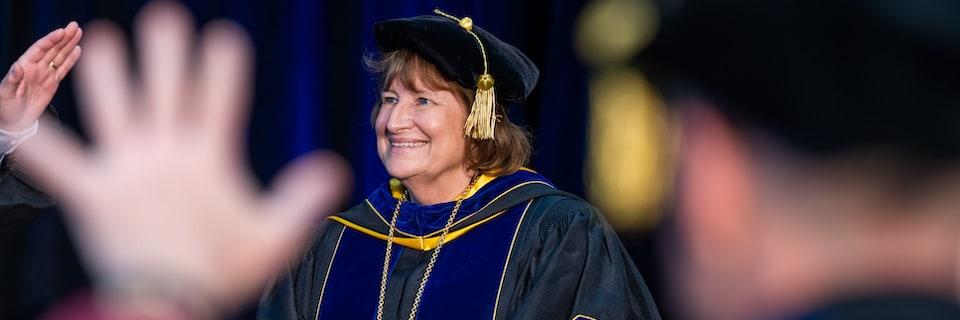Q&A With Sandra Cassady, Ph.D. on Making History

In November 2022, Rockhurst University etched a new chapter in its history, inaugurated its first lay, first female president, Sandra Cassady, Ph.D. In honor of Women’s History Month, we asked Cassady about her experience as a female leader and history maker in her own right.
Who have been some of the female leaders you looked up to in your career — either those you personally knew or who were examples from your own life?
Starting as a young girl, my mother was in the workforce. It wasn't a constant thing in our family, but she periodically would have a job. It was influential to me, setting that tone that women can go and have a career and work outside of the home.
For me, most of my undergrad was spent in what people call either the hard or the natural sciences — biology, chemistry, physics. And at the time, you might have a department of chemistry that's all men except for one woman. I found out later in just some conversations that there were times where it was very trying and very hard because some of male counterparts didn't think females should be there. But her being there really demonstrated for me that women can succeed in those fields as a student.
I did need that – when I took physics, there were a class of about 80 of us and there were maybe four or five women in the whole class. When I went to physics II, I was the only woman in the class. When I was a Ph.D. student, the program director came up to me when my husband and I were expecting our oldest child and said, “Well, I heard you're pregnant. Does that mean you're quitting the program?” And I remember saying it to him, “I'm pretty sure I can do both.”
Those are moments that you kind of think, well, somebody else might have walked away from it or have said, “They don't want me here,” something like that. But I kept going, and part of why was that I was very fortunate to have those role models. I was able to work with the first woman administrator as a vice president at the university, and then also the first woman president at St. Ambrose, Sr Joan Lescinski.
Do you think there such a thing as a “female” style of leadership? And if so, what are the traits of female leadership?
There's quite a bit in the literature on either female leadership or feminine leadership styles.
Personally, I think there's tremendous variability and how a man leads and how a woman leads. I think it's important to pull from both. In terms of the common characteristics of what might be considered the feminine leadership style, I think you find a collaborative approach, a willingness to listen to many viewpoints, the importance of team, empathy, compassion, humility. I think those are some of the most common characteristics that I've read about in women's leadership. But at the same time, I work with some men who do those terrifically too.
I think a leader needs to be able to adjust to different styles of leadership to different situations. In fact, there's a kind of a newer area of leadership called adaptive leadership where you make changes based on the needs of the situation. I think going through the pandemic is a good example of this. You saw leaders who may have always operated in a similar style and then all of a sudden something major changed in the world and we had to think differently and act differently.
Do you feel you ever had to work harder to distinguish yourself as a leader throughout your career?
Again, there's a tension between fitting those stereotypes and not fitting those stereotypes. Sometimes if you take a more assertive or top-down approach with an issue, you might find people kind of questioning that change in your disposition or in your style. There's that old saying about feeling like you need to work twice as hard to make it half as far, and in salary equity and some of those things, I think there's some pretty good documentation that women get paid less than men for the same kind of work at times. So I do think many woman have to work harder. But I think this generation of adults is doing a good job of kind of dispelling some of those myths, and that’s encouraging.
As the first female president inaugurated at Rockhurst, you will always be remembered as a trailblazer — what do you think of that title or that status?
I'm mindful that it's an opportunity to be a role model for others. I guess in my heart of hearts, I believe that boards of directors, or boards of trustees, as is our case here at Rockhurst, should select a person that they believe is best for the institution at that time in its history.
At one time almost all university presidents came from the provost position. And in the last couple decades, more and more presidents are coming from other roles at the university, recognizing that it's more than just a knowledge and a commitment to academics that makes a sound president. You need people who can fundraise, you need people who can understand the enrollment metrics and what's happening there, people who have certainly a deep grounding in finance. It's always interesting to read about who a new president and what their background was.
But just as importantly, I think the diversification of boards themselves has helped give women more leadership opportunities in higher ed. Having more women and more people of color on the boards themselves because they're able to look at an applicant pool in maybe a different or a new way and look at what specific skills each applicant would bring to the institution.
What advice would you offer female students today who are looking to become the next generation of leaders in their field?
I encourage our female students and all students to seize the opportunity to take advantage of opportunities to kind of hone their leadership. Be that person who's willing to help plan an event or a program, something that requires that you coordinate and organize and work with others.
Say yes to opportunities to serve on teams. Watch the leadership style of those around you. Engage in classwork about leadership. We have a class here at Rockhurst called the Magis Leaders Program that I was invited to speak at, and that group of, juniors and seniors had a chance to interact with other leaders and start building their networks. You just never know where those connections are going to lead and then how they might help a student in the future.







